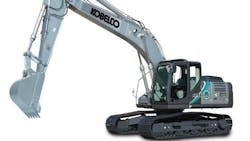Electrically based systems in construction machines differ in design and involve different components and processes.
Hybrid: The term has a number of definitions, but when used to describe an electrically based system in a construction machine, it usually is narrowly defined as a machine that can collect and store electrical energy that otherwise would be dissipated as heat, and then can use the stored energy to accomplish useful work.
Generator-motor: An engine-driven component, usually positioned between the engine and hydraulic-pump drive, that functions both as an electric generator and electric motor. As a generator, it supplies current to electric motors in the system and charges storage devices, such as batteries or capacitors. As a motor, it can add to the engine’s rotational force and can assist in driving the pumps.
Regenerative braking: This process lies at the heart of many hybrid systems and is defined as decelerating a moving mass by converting the kinetic energy of the mass into another form of energy that can be stored or used immediately to do work. The process occurs when current to an electric motor is cut off and machine inertia forces the motor to momentarily function as a generator. This occurs, for example, when the operator of a P&H L-2350 wheel loader lifts the throttle and shuts off current to the wheel motors, or when the operator of a Kobelco SK210HLC-10 Hybrid excavator releases the swing lever and the decelerating upper structure drives the machine’s electric swing motor as a generator.
Dynamic braking: The regenerative-braking process has a retarding effect on electric motors (functioning as generators) when the generated power encounters a load in the electrical system. The retarding effect is called “dynamic braking” and is further defined as “rheostatic” if the power is simply dissipated as heat across a “resistor grid.”
Capacitor: An electrical device that rapidly stores and rapidly releases large amounts of electrical energy.
Power inverter: An electronic device or circuitry that can change the characteristics of electrical current, often used to convert direct current (DC) to alternating current (AC).
Lithium-ion battery: A rechargeable battery that uses lithium ions to produce current. These batteries are gaining favor in mobile applications, given their ability to provide consistent power over extended run times. The capacitor is favored, however, in applications that require rapid storage and rapid discharge of large amounts of electrical energy.
Switched-reluctance: Manufacturers frequently cite “switched-reluctance” (S-R) motors and generators as an advantage in electrically based systems, saying that these components, compared with their conventional counterparts, exhibit higher power density; have a simple, reliable design; and are well-suited for high-speed operation.
IGBT Technology: Insulated Gate Bipolar Transistor is a term encountered more frequently as electrically based systems are refined for diesel/electric machines. Suffice it here to say that IGBT technology represents a significant advance in controlling these machines.
